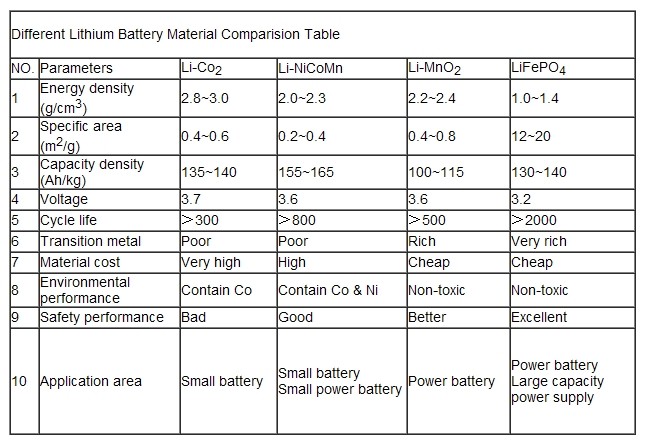
1.What is Lithium Iron Phosphate (Lifepo4) battery?
Lithium Iron Phosphate (LiFePO4, LFE) is kind of Li-Ion rechargeable battery for high power applications, such as EV car , Power Tool and RC hobby. Lifepo4 cells feature with high discharging current, non explosive, long cycle life ( >2000@0.2C rate, IEC Standard).Lifepo4 cell has 3.2V nominal working voltage and shall be cut-off power at 3.6-3.8V per cell during charging.
2. Why we choose lifepo4 battery?
Comparing with other batteries, lifepo4 battery has the below advantages:
a.High efficiency output:1-5C standard discharge, 10C continous discharge,20C burst discharge (20S)
b.High temperature tolerance:The battery can work well between temparture of -20-60 °C. Safe and no damage was caused.
c.The battery would not cause fire and explosion even damaged inside or outside.
d.Long cycle life. The capacity can be more than 80% after 2000 cycles.
e.Can be recovered even discharged to 0V.
f.Can fastly charged.
g.Low cost
h.No pollution.
Classified by the battery shell, even lithium battery can be divided into plastic shell, stell/iron shell, aluminum shell and pouch cell.All these lithium ion batteries have their own advantages. The technical data of their comparative performances is as follows:

3.What is depth of discharge (DOD)?
DOD, short for the Depth of Discharge, is used to describe how deeply the battery is discharged. If we say a battery is 100% fully charged, it means the DOD of this battery is 0%, If we say the battery have delivered 30% of its energy, here are 70% energy reserved, we say the DOD of this battery is 30%. And if a battery is 100% empty, the DOD of this battery is 100%. DOD always can be treated as how much energy that the battery delivered. For lithium batteries we do not suggest fully discharge them to 100% DOD, it would shorten the cycle life of batteries.
4. What is state of charge (SOC)?
SOC, short for the State of Charge, is used to describe how full a battery is. When a battery is fully charged, we can say that the SOC of this battery is 100%. SOC can be used to describe how fully the lead acid battery charged, cause lead acid battery always need to be fully charged for storage. Later nickel batteries and lithium batteries also take SOC to describe energy reserve. Here is a formula describing the relationship of SOC and DOD, that is “SOC = 100% - DOD”.
5. What is the Amp-hour (AH)?
The Amp-hour (Ah) is used for describing how much energy that battery can store in. The volume of the constant current (in amps) multiple with time (in hours) then got Amp-hour (AH) as battery capacity. For example, if a Bestgo-Power LiFePO4 cell, marked as “10AH @ 3C discharge, 25°C”, it means in 25°C condition, if discharge this battery with current no more than 30A (10AH, 3C), this battery can offer 10AH energy, like 30A current for 1/3 hour, or 5A current for 2 hours.
6.What is CC/CV mode?
Constant current / constant voltage (CC/CV) charging mode is a effective way to charge lithium batteries. When a lithium battery is nearly empty, we take constant current to charge it. We need to make sure that charging current should be lower than the max charging current that battery can accepted. With constant charing the voltage of battery is slowly upping, when battery volt reaches the max charging voltage, charger would make sure charging voltage fixed as "constant voltage" and reduce the charging current. When battery is fully charged this state would be stopped.
7.Lifepo4 pouch cell, cyclindrical cell, prismatic cell,which one is better?
Now there are mainly 3 shapes of lifepo4 cells, pouch cells, cylidrical cells, prismatic cells. Each type has it's own advantages and disadvantages.
A. Pouch cell.
Advantages: Light weight and with higher energy density. Can make small capacity, like 300mAh, 800mAH. Very suitable for equipment which require light weight, small size lifepo4 batteries. Like e-bike, UAV, inverstigation equipment ect.
Disadvantage: Can only be made into smaller capacity, fragile and very easy to damage the outside aluminum foil,easy to get swell after long time use. Capacity can't make big ones. Max 3.2V 50AH. Pack need professional soldering.
B. Cylindrical cell.
Advantages: Cylindrical cells are very flexible to make different size battery packs. Sizes are normally, 14500, 18650,26650, 26700, 32650, 32700. Capacity from 500mAh to 6AH.
Disadvantage: Single cell capacity small and battery pack need soldering. To make big battery packs need a lot cells in series and in parallel. If one cell in the pack have problem after some time using, very hard to replace single cell.
C. Prismatic cell.
Advantages: Hard shape and strong alumium case. Capacity can be as high as 310AH single cells. Can support high current discharge/charge. Hard shell make the battery safer. Very suitable for big battery packs for Electric vehicles, telecom station building, solar styem, energy storage system. Screw terminal, very easy for pack composing or cell replacing. If one cell in the pack have problem, just need to replace the problem cell and other cells can be kept.
Disadvantages: Fixed shape, can't fit some customized size cases.
You can choose the exact cell type based on your detail application environment.
If you have any other questions about our lifepo4 battery, please feel free to contact our technology team by email info@benergytech.com!




